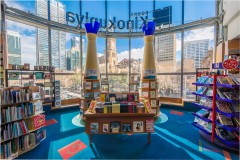Elemental and the act of looking out | An essay by Laura Thompson

Rohan Hutchinson is recognised for his large-scale and cleanly articulated photographs which capture the geographic, economical and historical frameworks which inform space, habitation and architecture. In his new series Elemental, Hutchinson fosters a new perspective to these themes, from the inside looking out. For this series, Hutchinson drew inspiration from Japanese architect Go Hasegawa whose designs consider the relationship between built and natural environments. Hasegawa’s study on the basic principles of a house was the basis for Hutchinson’s renewed perspective.

On residency in Blairmore, Canada in 2014, Hutchinson undertook two simultaneous studies photographing the conditions and environment inhabiting the region. Hutchinson entered the homes of local residents and photographed the external environment from within. With shallow depth of field, the resulting works show rain, snow and ice on the surface of the inhabitants windows in intricate, crisp detail. For the second study, Hutchinson documented the surrounding dominating landscape.
In architectural manifestations or in consumerism itself, we form structures and systems in response to our immediate needs. The home offers security and amenity, it also provides a space to interact, to dwell and is loaded with memories and identity. In his text The Poetics of Space French philosopher Gaston Bachelard articulates how spaces inform our lived experience and he uses the house as a metaphor to represent body and mind (Bachelard, G. The Poetics of Space. France, 1958.). The attic for Bachelard is a space for reflection, whilst the cellar hosts dark and abandoned thoughts.
In Elemental, Hutchinson captures the act of looking out and contemplating the external world from an enclosed and private space.
In the first presentation of the new series, two of the interior views, or ‘window studies’ are transparent prints suspended in the gallery space. Placed in front of the external landscape images, their transparency and distancing mimics that of the windows themselves. The viewer must navigate and consider their position, questioning what lies before, beyond and even in between.

While an internal space provides a practical means to survey the external environment, Hutchinson reminds us that the structure of the space itself is influenced by the world outside.
As Costica Bradatan writes in The Wisdom of the Exile: “Not only do you occupy a certain place, but that place, in turn, occupies you. Its culture shapes the way you see the world, its language informs the way you think, its customs structure you as a social being. Who you ultimately are is determined to an important degree by the vast web of entanglements of ‘home’” (Bradatan, C. The Wisdom of the Exile. The New York Times, 2014).

When the notion of ‘home’ is extended to a large geographical region, its conditions cannot always be structured or controlled. As Hutchinson charts the natural environment from an internal viewpoint, we develop an understanding of architecture and its constitutive edges – inside bodies, communities, history, culture – from a new side.
Laura Thompson, 2016
Elemental shows in Wedge Gallery from July 2nd – 19th.



Write a comment
This is a necessary element—that is, the criminal act must be voluntary or purposeful.